The notion of ‘identity’ cannot be pinned down as having one definition. For the purpose of this post, I define identity as a socially and personally created label one can embody, shed, defend, create, and mold (not necessarily used at all–or at least not in this order). When used in terms of immigration, the presence of identity can move in one of many ways:
1. Relying on the Traditional and Comfortable
Mrs. Suri, one of the minor characters in Tarquin Hall’s Salaam Brick Lane resides in London, yet she remains solidly committed to the Indian views and traditions regarding marriage. She lives in a city among millions of people from all backgrounds. She does not adapt; she surrounds herself with the familiar. Some would confuse this with stubbornness. Committing to the comfortable is a choice you make when you reflect on your own identity. You can let outside perceptions to mold how you carry yourself, or you can resist. The latter results in a situation similar to that of Mrs. Suri. You stick to your identity you created for yourself long before immigrating to a new place defined by very different identifying features.
2. Voluntary Adaptation
The Shri Swaminarayan Mandir in London has in many ways voluntarily adapted itself as a modern place of worship set several thousand miles away from India and, more importantly, the Ganges River (one of, if not the most important site in Hinduism). They expect non-Hindu visitors to the mandir, as indicated by an extensive exhibit tracing the main tenets of the religion. Certainly, places like St. Paul’s or Westminster Abbey have taken on a revised role as a tourist attraction, but you will not find there a museum describing the history or practices of Christianity; that’s left for the history books. The massive Hindu temple stands out in its relatively modest surroundings (except for a slight view of Wembley Stadium in the distance), so naturally it will garner some attention. The mandir, however modern, does not seem to lose much of its traditional identity. Hinduism thrives there; thousands are said to pray in the building during the day and more so during holy days.
The BBC has a link to some of the other ways Hindus have had to adapt to a new identity in 21st century, but I am unable to access it on my computer. I suggest taking a look, for it looks informative and will certainly give a much more comprehensive understanding than I can.
3. Hesitatant Adaptation
While the Hindus have voluntarily adapted themselves to modern London, the Sikh community – as understood after a visit to the Gurdwara Sri Guru Singh Sahaba in Southall – has taken some hesitant steps as enforced by British law. For example, one of the five tenets of Sikhism calls for the carrying of a sword for the defense of the weak, justice, and as a representation of God. British law forbids this, so this tenet cannot be fulfilled in 21st century Britain. A second tenet of Sikhism calls for uncut hair, as to symbolize, in part, one’s comfort with how he/she was physically created by God. For many jobs in Britain, one’s hair must be cut and trimmed, and some Sikhs decide to cut their hair accordingly. They lose part of their identifying features as a Sikh when faced with the new identity demanded of them by surrounding British culture. The gentleman who showed us around the gurdwara expressed his desire for all Sikh men to be allowed to carry their ceremonial swords, for, on that day, the two conflicting identities can coexist without having to forego one or the other.
Post-colonial literature points to this hesitant adaptation, but from a different perspective. Buchi Emecheta’s Second Class Citizen traces the difficulties several Nigerians face when trying to willingly adopt the British culture. Racism, prejudice, and misconceptions form a glass ceiling that essentially blocks the immigrants from moving away from their status as a ‘second-class citizen’. The hesitation can be drawn from the communities themselves or from a host identity defined by prejudice; one party cannot take full blame for the contrast between different peoples.
_________________
The construction of identity in the London of 2009 immediately appears like a forever mixed jumble of different practices, rites, and customs fighting for its own place of comfort. I see it as being in a state of disequilibrium, where the role of prejudice and anti-immigration compete with the openness and accommodating nature of some Londoners. Some want to enjoy their own separate community and their own traditions; others are willing to adapt and let their surroundings mold their identity. Neither is wrong, neither will prevent one from having a fulfilling life.
Whew.
I still question my views on this topic, for it is a dense subject to write about. I look forward to the day I come to some brilliant understanding of identity construction and its adaptation/resistance when facing a new identity. Until then, I remain confused, frustrated, and exhausted.
Categories: Brandon
Tagged: 21st century London, Hinduism, Identity, Sikhism
So I’m a bit behind in the posts, and I actually have things I’m supposed to write about rather than just blab on about feet or other nonsense. Qualls wanted us to look at immigrant communities. By wondrous fate, Audrey and I came across a Jewish festival in Regent’s Park. The festival was called Klezmer in the Park, a Jewish music festival. The MC was fantastic and quite hilarious; he even sang a Yiddish rendition of of New York, New York. He brought up an interesting point though: what would an English rendition sound like? With my humble German abilities, I was able to ascertain that he was not speaking in a direct translation, and I wonder how a song(in general) gets changed, either culturally or linguistically, when it comes to a different country. This seems to apply even more prevalent for a song like New York, New York, which is so heavily tied into the culture of a city and its lexical nuances. Back to immigrant communities. It was quite a sight to see, truly. Jews and non-Jews; British and non-British; all dancing and laughing together in Regent’s Park. Such a feet would not have been possible or even dreamable only a short time ago. And yet there it was, in all of its schmutzing glory. What I did find interesting though, was half way through the concert, the MC calls all the male bachelors too silly to avoid his gaze up on stage. While up there, they were bombarded with what I can only imagine were questions a Jewish mother would ask (I have no such mother, so I’m not really sure). What was sad was that no one liked the Jewish men, rather preferring a gardening British non-Jew (evidently Jewish men don’t do well with their hands, I’ll have to ask Barron). But I think this brings up an interesting idea, and one we have touched on before: how do you maintain your cultural identity while continuing to integrate (thus attaining privileges like a festival in the park). How do you maintain a culture that is based around the maternal family line if people are marrying non-Jewish women? While the festival did not speak for the entire British-Jewish community, I would like to believe that it had some microcosmic properties. Next Audrey and I went to Queen Mary’s Garden; it was quite lovely, beautiful flower patches with little roads cutting into the wooded areas, very nice for intellectual conversations and peaceful walks of contemplation, recommended to all.
Now onto what I wanted to talk about: tourists. Bloody tourists. So buddies of mine arrived here a week or so ago, and it’s really startling how loud and boisterous they are. But in saying this, I have to laugh because I cannot be so bold as to say I have transcended the lines of tourist and Londoner–that would be absurd. How snobby does that sound? Quite. I wouldn’t go as far as to say I’m going native, but I think I’ve definitely fallen into a slot of participant observation. But I mean, this is the dream. If I could do ethnographic work for the rest of my life, earning enough to eat and not get trench foot, I would die a happy man. Saddly I realize that isn’t the case, and I’ll just end up behind some desk. So I’ve got to play dress up for as long as I can before the bell tolls, hopefully not making too much of a fool of myself in the process. Keep calm, carry on.
Anyway, cheers
Categories: Andrew R
Tagged: going native, Klezmer in the Park, language barriers in music, Queen Mary's Garden, The Regent's Park, Yiddish
September 7, 2009 · 1 Comment
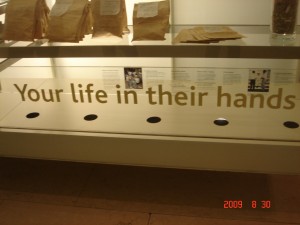
A description under Cradle to Grave by Pharmacopoei states:
“Cradle to Grave explores our approach to health in Britain today and addresses some of the ways that people deal with sickness and try to secure well being.”
It is an understatement when I say that I was surprised to see an exhibit titled “Living and Dying” which is located in Wellcome Trust Gallery in the British Museum. The gallery explores how people around the world deal with “the tough realities of life and death.” The exhibit further explores health challenges shared by many through out the world, and the ways that those individuals might deal with them based on their cultures, beliefs, and areas of residence. Creatively displaying visual representations of photography, quotes, documents, captions, and instillations the exhibit investigated people’s reliance on relationships in order to maintain their well-being. Exploration of people’s relationships with each other, the animal world, ancestors, land and sea for their well being are included.
As I walked down the stairs of the British Museum to the ground floor expecting to see the Aztecs (Mexicana) exhibition featuring tribal sculptures, history, and art instead I was greeted by Cradle to Grave. The central installation consists of two lengths of fabric illustrating the medical stories of a man and a woman. Created by Susie Freeman, who is a textile artist, David Critchley, a video artist, and Dr Liz Lee, a general practitioner, each piece contains over 14,000 drugs representing the estimated average prescribed to every person in Britain in their lifetime, tucked away in ‘pockets’ of knitted nylon filament. This specific piece explored the approach to health in Britain and the personal approach of the piece demonstrates that maintaining well-being is more complex than just treating illness. With 14,000 drugs, the artists included photographs and some treatments that two individuals have gone through. The common treatments for the man and a woman included an injection of vitamin K and immunisations, and both individuals have taken antibiotics and painkillers at various times. Other treatments were more specific such as for asthma and hay fever that the man suffered from when younger and quitting of smoking at seventy due to bad chest infection. The piece showed his death from a stroke at the age of seventy-six, “having taken as many pills in the last ten years of his life as in the first sixty-six.” The woman’s treatments included contraceptive pills and hormone replacement therapy. She was successfully treated for breast cancer. She is still alive at eighty-two although she does suffer from arthritis and diabetes.

Trying to figure out the purpose of the exhibit, I believe the artists are trying to explore the factor of living in the “modern” society and how treating an illness is not the only factor that needs to be taken into account. By representing two individuals, a male and a female, in the British society through photographs with their own captions written down, and objects such as contraceptive pills, a glass of wine, and needles allowed the viewers to relate in some way to the lives these characters have led and how it affected their health.
Surrounding the installation, representations of health in countries such as Tanzania, China and India were included. “Facing HIV/AIDS” explored the approaches these communities have to the AIDS epidemic. The stigmas attached to being diagnosed with AIDS in these societies prevent many from seeking treatments; therefore, the need for education programmes, community workshops and poster campaigns which aim to make it easier to discuss and practice safe sex. “Praying for Health” showed how certain communities use prayer and traditional medicine to treat their illness. In contrast to the British healing, it is a very different approach. Focusing more on the person and the higher being rather than the pharmaceutical companies and the business aspect, societies in Tanzania, India and China focus on the being and their needs. Although the treatment of such illnesses such as HIV/AIDS can not be done only through traditional healing, their approach should serve as a guide to western societies where a more humane way to treat patients. There needs to be an infusion between the two worlds.
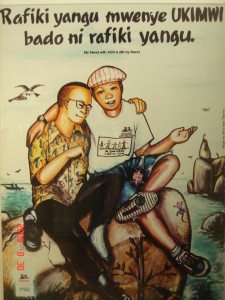
"My friend with AIDS is still my friend."

Categories: Jeyla · Museums
Tagged: "Living and Dying", Health, The British Museum
All I could think about when I was at Oxford was: “what a privilege”. What a luxury it must be for the students that come here, to be in a university which is in the top ten best universities in the world, to be a Rhodes scholar. Not that I do not appreciate the education I receive, but Oxford University is the most idyllic place I have ever seen. When looking at the gardens of the beautiful colleges, the bikes, the lovely stone buildings, I could almost see the students from the 18th century discussing their ideas at the quad, wearing tweed jackets and going punting in the river.
Of course, this privilege has, traditionally, only been enjoyed by those that grew up privileged. Most of the students at Oxford attended what we know as private schools. This is something else I learnt about England: state schools are what we consider to be private schools. Yes, it’s really complicated. But as I was mentioning, admissions to Oxford still continue to be controversial, specially after the Laura Spence Affair in 2000. Spence was a state public school student who had perfect grades in all of her GCSEs and A-levels, something that would secure her a place in Oxford for sure, but in the end, did not get in. Oxford said that it was because she did not show potential, but people say it was really because of her northern England working class and state-school background. Finally she ended up getting into Harvard with a full scholarship.
However, I realize that, in the end and in the long run, it doesn’t really matter whether education is very expensive, or for free. Higher education is a right and not a privilege in many countries, yet there is many people who just cannot afford the time to go to university and need to start working instead. A student has to be able to afford the time to study.
On another note, I think it will be interesting to compare Oxford with UEA later on, specially because, as I understand it, they have very different structures as institutions of higher education.
Categories: Azul
Tagged: Oxford
After visiting two different temples and observed two different cultural groups in their own religious institutions, we must wonder, how are we going to think of them? We must now think about our small overt participant observation because the politics of representation are extremely important. Our impressions of Catholicism, Sikhism and Hinduism should not the participants, the Other, as exotic, or a romanticized version of them. Although it is true that we are always somewhat biased, we can make the effort of being less so by informing ourselves, carefully listening, and above all, observing in a critical way.
Karl Marx once said that religion is the opium of the people. Anthropology however, has said that while religion is a social institution that appeals to every individual in a society, each one at the same time makes his or her own meaning of religion. Religion, as a component of culture, that is, the practice of beliefs, is always changing. It adapts to the passing of time, and especially to globalization processes. England is one of the best examples to understand how cultural practices adapt in a different way when in a different country. What I considered to be the most valuable lesson of the whole experience, is actually proving by looking these places of worship, that different religions, from a sociological standpoint, are the same.
On the last three days here in London, we saw how religion has moved many people throughout the centuries, starting in Oxford University, the birthplace of the British academia, which was founded by monks, and where every College had its own chapel. To this day, the chapel of your college remains the most important place of congregation if you are a student at Oxford. Even in what we consider the “secular Western world”, religion is still very much important.
In the case of the Sikh and Hindu temples, what struck me the most were our guides. The discourse was so alike in so many ways. It always amazes me how every religion claims to provide the ideal lifestyle, and to appeal to everyone across society, and to be the most comprehensive one. It is clear that every people wants to be “the chosen people”.
Some people think that we are always biased. Following many social scientists, I will claim that we must locate ourselves in the context in which we are observing our subject and not think that our experience can be representative of The Sikh, or The Hindus. Who are these guides? What has their experience been with their religion? Would we be observing different cultural practices in a Hindu temple in Nairobi or some other city in another country? In that sense, I wish we could have learnt more about how the cultural practices of these religions have adapted in time, and to the city of London. But for that, further research would be required.
Categories: Azul
Tagged: Hinduism, Oxford, Religion, Sikh
I try not to be biased against a museum’s collection because of its particular layout, especially one as restricted as Sir John Soane’s, but I feel that Mr. Soane’s museum was just too prohibitively small to have the kind of impression that he himself wanted it to. The stated purpose of John Soane (an architect by trade) turning his home into a museum was to “preserve [his] house and collection for the benefit of ‘amateurs and students’ in architecture, painting and sculpture.” Rather than gain any further concrete knowledge of these subjects at the Soane, I felt cluttered by what just instinctively felt like cartoonish opulence.
The signage was so sparse that I learned about one in ten of the individual objects rather than collections as a whole and how they relate to Soane or his areas of expertise. I doubt an audio tour would have even been able to cover much of the collection, either. I did get a sense of the importance of Mr. Soane’s work itself, but even this part of the museum consisted of many of his drawings gave me no sense of the arc of his career or his greater role in architecture. As I addressed in my V&A post, an eclectic collection is not enough to doom a museum to failure, but the Soane just fails to create any concrete impression on its guest besides the feeling of being overwhelmed by amazing and historic things.

Rowing graffiti at Corpus Christi College
Oxford is overwhelming in a much better way, if that makes any sense. I won’t speak for the group that did not have a good guide, but I think I got as good a sense of the past and present at Oxford (which are pretty much the same) as one can get when students and faculty are not there. I was glad at first to not be going to Oxford when classes were in session (so as not to be a gawking tourist), but now I wish I’d been able to see Oxfordians (Oxforders? There’s probably a much cooler name than those that us outsiders aren’t supposed to know) interact with the place. Don’t get me wrong, I was delighted to admire the buildings on their own (particularly the dining halls, which are even more stunning than in movies like Chariots of Fire [actually I think that’s at Cambridge]), but going when the University was entirely empty almost made it seem like a museum made from an abandoned University rather than one of the current greatest academic institutions in the world.
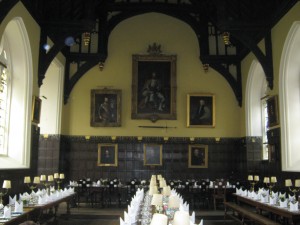
The Dining Hall at Oriel College
All of this will help me decide when to go to Cambridge, as will my desire to stay away from tourists there for the shopping. Although I walked around and saw plenty of the University before the tour, I didn’t really believe I was in Oxford until I entered that quad at Lincoln College and felt shut off from the street performers, KFCs and the like. I wonder how the sheer volume of tourists affects students’ ability to have a truly authentic Oxford experience like their predecessors (Brandon asked something like this, but I think our guide was confused). Similarly, I wonder if the cache of living in Oxford has driven housing prices so high that many of those who work at the University must live farther away. All things to explore when I make another pilgrimage one day.
Categories: Aidan
Tagged: Museums, Oxford, Sir John Soane's Museum, Tourism
There will never be complete peace and unity with a community. Unfortunately, the same is true for a religious group. There will always be arguments between the more orthodox members of the society and how they interpret scripture, rules, or messages, and the younger generation that was raised in a very different world from their predecessors. In some cases, these arguments lead to forward progress for the religion as a whole, for example with more equality for women or more opportunities for all members of the congregation. However, just as often if not more so, this can lead to divides and people leaving the faith altogether.
In many ways Sikhism and Hinduism are very similar. Both religions believe that shoes should be removed before entering the inner sanctum of the temple, that peace is a necessary force in life, that donations and charity will hold you in higher stead with the god(s), and that life is a journey to learn from. However, when observing the people at the Sikh and Hindu temples I discovered another thing that both religions prize – children. There was a definite sense that the children were learning to respect their religions from a very early age. In the Gurdwara I saw a little girl of about 4 tying a headscarf onto her squirming little brother. Obviously this girl had learned that in her faith, covering your head is necessary inside of the temple. In the Hindu temple, many young children went up to their parents to get change to offer to a particular deity in prayer.
The other thing that struck me as interesting was how the Sikhs and Hindus have adapted to being in the United Kingdom. Some changes are quite obvious, the Sikh men cannot carry their defensive swords due to British law. However, it is interesting to consider that some Sikhs have been forced to remove their head-covering or trim their facial hair due to the parameters of their jobs. The changes for the Hindus are not as obvious. It is, of course, possible that some Hindus have rejected the idea of obstaining from meat and fish since entering the UK, but that doesn’t seem to have the same direct correlation as with the Sikhs and their changes.
Although this blog post is supposed to focus mainly on the Sikh and Hindu religions, I would find it amiss if I did not mention problems and arguments within my own faith. I stated at the beginning of the post that all religions have problems, but sometimes the butting-of-heads between the younger generations and those who are more set in their ways can end in forward progress. I’m a practicing Roman Catholic and I know that my religion is not perfect. However, I think that the stubbornness of those people who are high up in the Catholic hierarchy on the issues of married priests, female priests, homosexuality, etc. are going to cause the faith I believe in to crash and burn in the future. (Can you tell I’m liberal?)
In many ways, this links directly to the Sikhs and the Hindus. Both are being forced to adapt to their surroundings, both religiously and culturally, in Britain; some as second-generation immigrants who believe in their religion to a degree and others as die-hard orthodox followers. In order for their religion continue to have forward progress, these people need to sort out their differences long enough to come to a consensus. I hope my Church will do that too.
Categories: Kelley
Tagged: Children, community, gurdwara, Hinduism, Progress, Sikhism, Temple
September 6, 2009 · 1 Comment
No museum has affected me as viscerally as The Victoria and Albert Museum in South Kensington. Immediately upon entering the museum I was struck by the sight of life-sized Rodin sculptures of the human body that were raised above eye level, which created, for me, a sense of the insignificance of the appreciator, and likewise, the importance of art over all things. These sculptures were grotesque; Rodin used a technique that rendered them black and raw-looking, as if they had once been alive and thrown into a fire, then the charred remains removed and put on display. Though they were shocking and somewhat disturbing, Rodin’s pieces elicited in me a very emotional response, one that cut to the core of my perceptions of the self and of humanity, and one that I can neither explain nor recreate for the reader.
I also really enjoyed seeing several sculptures by Alfred Stevens, including a copy of the original “Truth and Falsehood” which is a part of The Wellington Memorial which we saw at St. Paul’s Cathedral several days ago.
The fashion and jewelry exhibits at the Victoria Albert were equally as touching, but for different reasons. Coming from a background in feminism, I was disappointed in those women who conformed to societal ideals of beauty – women who cinched their waists and bustled their butts, weighing themselves down with heavy jewelry, changing and shifting and molding themselves to ‘fit,’ quite literally, into the beauty myth. One display featuring a bustle and the wooden innards of a hoopskirt were reminiscent of a cage. And would it really be so far from the truth if it were?
Another exhibit which really hit me was photography. A great little exhibit, though I do wish it were larger. I thought that all of the works were quite good, though I connected on a deeper level with just two prints. The first piece was strikingly different. The artist worked with the principles of light and photography and used the sun to burn a simple design into the photo paper. I didn’t quite understand the process by which the piece was created but that’s the beauty of art, isn’t it? You don’t always have to understand it, or at least understand it as the artist does.
One piece that I definitely took a bit of “viewer’s license” to form my own interpretation was a photograph of a beautiful black model in a traditional Georgian dress and wig – both stark white. In her delicate hand she held a large diamond, perfectly cut and gleaming. Her head tilted towards the diamond in her hand, yet her eyes remained fixed intently on the camera. I thought that this piece, out of all the pieces of artwork I have seen at any exhibit thus far, had the most to say. It powerfully conveyed, by capturing just a single moment in time, hundreds of years of British imperialism and the pain it caused the imperialized. The Africans and West Indians were brought to perhaps not-so-‘Great’ Britain and taught that being ripped from their homelands like so many weeds was a privilege. They drowned the enslaved in western culture, which is represented by the model wearing the white (this was surely no mistake) Georgian garb, and meanwhile robbed their homelands of natural resources – such as diamonds and gold – for their own profit.
“Has imperialism, has slavery, really ended?” one must ask him or herself when one considers that there are still related issues in today’s society. The answer should become glaringly apparent when one considers Westerners’ continued thirst for diamonds. Though our presence in the diamond mines of Africa, in places like Sierra Leone, The Democratic Republic of Congo and Angola, may not be physical, our socially-sculpted ideologies surrounding the institution of marriage perpetuates these issues, and exacerbates the problems surrounding blood diamonds. So, for all you ladies out there: next time you stare doe-eyed into a Zales’ display window and exclaim in “I can’t wait to get married!” think twice about what societal forces and social constructions may be at work when you consider the “necessity” of an engagement ring. And the next time you look at a piece of art, everyone, look a little deeper and listen a little closer to what the piece may be trying to say.

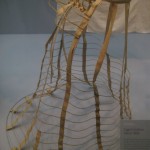
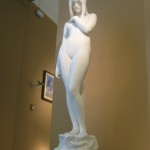



Categories: Anya · Museums
Tagged: blood diamonds, Fashion, Feminism, photography, sculpture, the "white man's burden", the beauty myth, The Victoria and Albert Museum
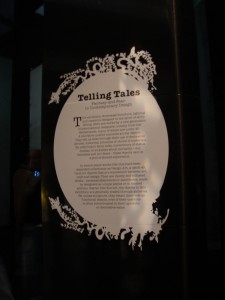
Outside the 'Telling Tales' exhibit
There were many things I adored about the V&A museum: the entrance way of marble Greek sculptures, the fashion wing including one of Princess Diana’s dresses. But what took my breath away the most was the fairy tale exhibit, Telling Tales. As many of you know, I have a childlike obsession with fairy tales and Disney movies, especially the Little Mermaid. But it is not the Disney story or the catchy songs that make me love these stories even as the years go by, but rather the way that these stories can transform a young child’s hopes and dreams into a story that suspends reality. These stories create a new world where children can hide for a little while. Who wouldn’t love that?
Well the Telling Tales exhibit at the V&A museum did just that: suspend reality and take the audience into a magical fantasy world. The works of art on display were amazing manifestations of the classical fairytales in furniture and sculpture. But that was not even the best part of the exhibit, rather it was the way that entire space was like a fairytale. Each room followed a different theme: the forest glade, the enchanted castle, and heaven and hell. To say that each of these rooms’ atmospheres matched their titles would be an understatement. When I entered the first room, the enchanted forest, all the walls and lighting matched that of a forest. It was likewise for each room. With this, the exhibit was able to achieve exactly what a fairytale is meant to: suspend reality.
The V&A museum mostly deals with exhibitions about design. Besides the suspension of reality, this show captures the elements of fairytales: dreams, hope, fear, beauty, and of course happy endings. Although the exhibit ended darkly with the heaven and hell room, I think in this way it remained grounded in realtiy. Afterall, we are not in a fairytale. And eventually the suspension of reality ends. And what better place to end it than with death, where everything ultimately ends?
Note: Photo slideshow of the V&A museum to come soon. However the Teling Tales Exhibit did not allow photography inside.
Categories: Megan · Museums
Tagged: dreams, fairy tales, Museums, reality, Victoria and Albert Museum
When people hear the word Oxford, they think of a very selective and highly demanding school. And it’s true; the University of Oxford is an elite institution. However, Oxford usually doesn’t conjure up images of the town itself. I will not deny that parts of the town were beautiful, but many parts were a bit too touristy. At certain points throughout Oxford I felt as if I was just walking through a series of strip malls. Such sights were not what I expected Oxford to look like at all; instead I thought I would be seeing just a picture perfect small college town.
On top of this, those “lucky” enough to have been with a certain tour guide are aware of how boring Oxford can be made to be. I know our tour guide had the best intentions, but the manner in which he toured us around Oxford made me want to fall asleep. If that is a glimpse of the Oxford experience, I’ll gladly take Dickinson.
That said, the colleges of Oxford are amazing. The architecture is beyond belief and to have the opportunity to study at one of the colleges would truly be a privilege. The dining hall we visited was extraordinary and surprisingly cheap to eat at (3 pounds for a meal if I remember correctly). Speaking of prices, I have to say that the price of tuition caught me off guard. To pay only 9,000+ pounds in order to attend this elite institution is something I am still trying to wrap my mind around. If only Dickinson would follow suit…
Something I found particularly interesting was how hostile the university was to the sciences. Having a completely separate science library so that it wouldn’t “infect” the classical studies of the students is fascinating. Though it does make sense now that I think about, I still believe that such an attitude shows just how far we have progressed; science is no longer seen as an enemy (at least by those who can actually think on their own).
In the end, the University of Oxford was truly an awesome experience. Though the tour guide was a bit boring, he still explained the history very well (and made us ponder the universe and infinity). I only wish the town of Oxford itself was less touristy and less ritzy.
Categories: Andrew F
Tagged: Architecture, Oxford, Progress, Tourism, Tuition















